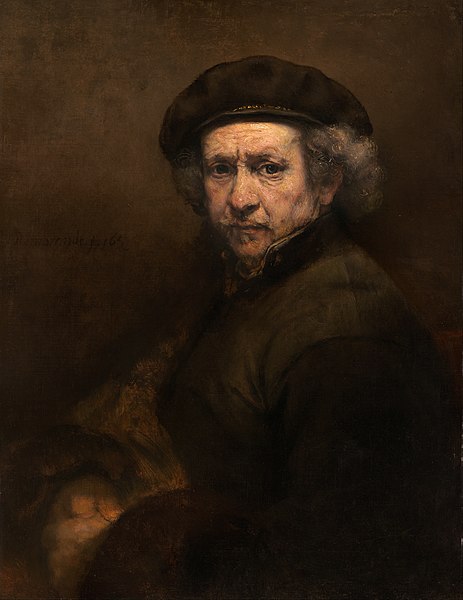
Born: 15 July 1606, Leiden
Died: 4 October 1669 (aged 63)
Period: Baroque, Dutch Golden Age
The Life of Rembrandt van Rijn
Rembrandt Harmenszoon van Rijn, widely recognized as one of the greatest visual artists in the history of art and the most important in Dutch art history, was born on July 15, 1606, in Leiden, the Netherlands. His life and career were marked by extraordinary artistic achievement and personal trials, reflecting the full spectrum of human experience in his works.
Rembrandt’s early years were spent in Leiden, where he was born into a family of relatively modest means. His father was a miller, and his mother was a baker’s daughter. Showing early talent, Rembrandt began his formal art training at a young age, first with a local artist in Leiden and later in Amsterdam with Pieter Lastman, who was known for his historical paintings. Rembrandt quickly absorbed and surpassed his master’s teachings, returning to Leiden to begin his career as an independent artist.
In 1631, Rembrandt moved to Amsterdam, which was rapidly becoming a vibrant artistic and commercial center. There, his career flourished. He became renowned for his portraits, historical paintings, and etchings, capturing the essence of his subjects with profound empathy and remarkable attention to detail. His use of light and shadow, known as chiaroscuro, added dramatic intensity to his works. During this period, he received numerous commissions from wealthy patrons, which allowed him to live comfortably and collect art and antiquities.
Rembrandt’s personal life was filled with both joy and tragedy. In 1634, he married Saskia van Uylenburgh, who came from a well-connected family. Their marriage brought him into higher social circles, but it was also marked by sorrow. They had four children, but only one, Titus, survived infancy. Saskia’s death in 1642 deeply affected Rembrandt, and his art from this period reflects a somber introspection.
Financial mismanagement led to Rembrandt’s bankruptcy in 1656, forcing him to sell his house, his printing press, and his collection of art and antiquities. Despite these setbacks, his later years were some of his most productive and innovative. He continued to work tirelessly, creating some of his most celebrated works, including “The Jewish Bride” and “The Syndics of the Drapers’ Guild.” His style became more expressive and less concerned with detail, focusing instead on the interplay of light and shadow and the emotional state of his subjects.
Rembrandt died on October 4, 1669, in Amsterdam. He left behind an unparalleled legacy, with a body of work that includes around 300 paintings, 300 etchings, and 2,000 drawings. His art, which spans from vivid portraits and self-portraits to dynamic landscapes and narrative scenes from history and the Bible, continues to be admired for its humanity, emotional depth, and technical mastery. Rembrandt’s influence on future generations of artists has been profound, securing his place as a titan in the world of art.
Rembrandt van Rijn’s Notable Works
Rembrandt van Rijn is celebrated for a vast array of works that have had a profound impact on art history. Here are ten of his most famous works, recognized for their technical mastery, emotional depth, and profound humanity:
- “The Night Watch” (1642) – Officially titled “Militia Company of District II under the Command of Captain Frans Banninck Cocq,” this painting is renowned for its dramatic use of light and shadow and the dynamic composition of its subjects, a city militia.
- “The Anatomy Lesson of Dr. Nicolaes Tulp” (1632) – This work depicts Dr. Tulp demonstrating the dissection of a cadaver to a group of medical professionals, showcasing Rembrandt’s skill in rendering human anatomy and his ability to capture a moment in time.
- “Self-Portrait with Two Circles” (circa 1665-1669) – Rembrandt produced numerous self-portraits throughout his life, but this is one of the most celebrated, notable for its introspective quality and the mature, self-assured gaze of the artist.
- “The Jewish Bride” (circa 1665-1669) – This painting, which depicts a couple in a tender embrace, is admired for its emotional depth and the rich, warm color palette.
- “Syndics of the Drapers’ Guild” (1662) – Known also as “The Syndics,” this group portrait of the Amsterdam drapers’ guild is a masterpiece of composition and subtle interaction.
- “The Storm on the Sea of Galilee” (1633) – Rembrandt’s only known seascape, this dramatic scene captures the terror and awe of a storm, with Jesus calming the sea. Notably, the painting was stolen in 1990 and remains missing.
- “Danaë” (1636-1643) – This depiction of the mythological figure Danaë, visited by Zeus in the form of golden rain, is celebrated for its sensual beauty and complex use of light.
- “Aristotle with a Bust of Homer” (1653) – This painting, which shows the philosopher Aristotle contemplating a bust of Homer, is rich in symbolic detail and reflects on the value of art and knowledge.
- “The Return of the Prodigal Son” (circa 1661-1669) – One of Rembrandt’s later works, it explores themes of forgiveness, redemption, and human vulnerability through the biblical story of a wayward son returning to his father.
- “Bathsheba at Her Bath” (1654) – This painting, which depicts Bathsheba contemplating a letter from King David, is notable for its intimate portrayal of inner conflict and its luminous treatment of the human figure.
These works, among others, cement Rembrandt’s reputation as a master storyteller and a painter of great emotional and psychological depth, whose influence extends far beyond his own time.